As an Amazon Associate I earn from qualifying purchases.
Harvesting elderberries is a rite of summer or early autumn for people all over the United States, Canada and Europe. Here are some tips and tricks for harvesting elderberries when it’s elderberry season near you.
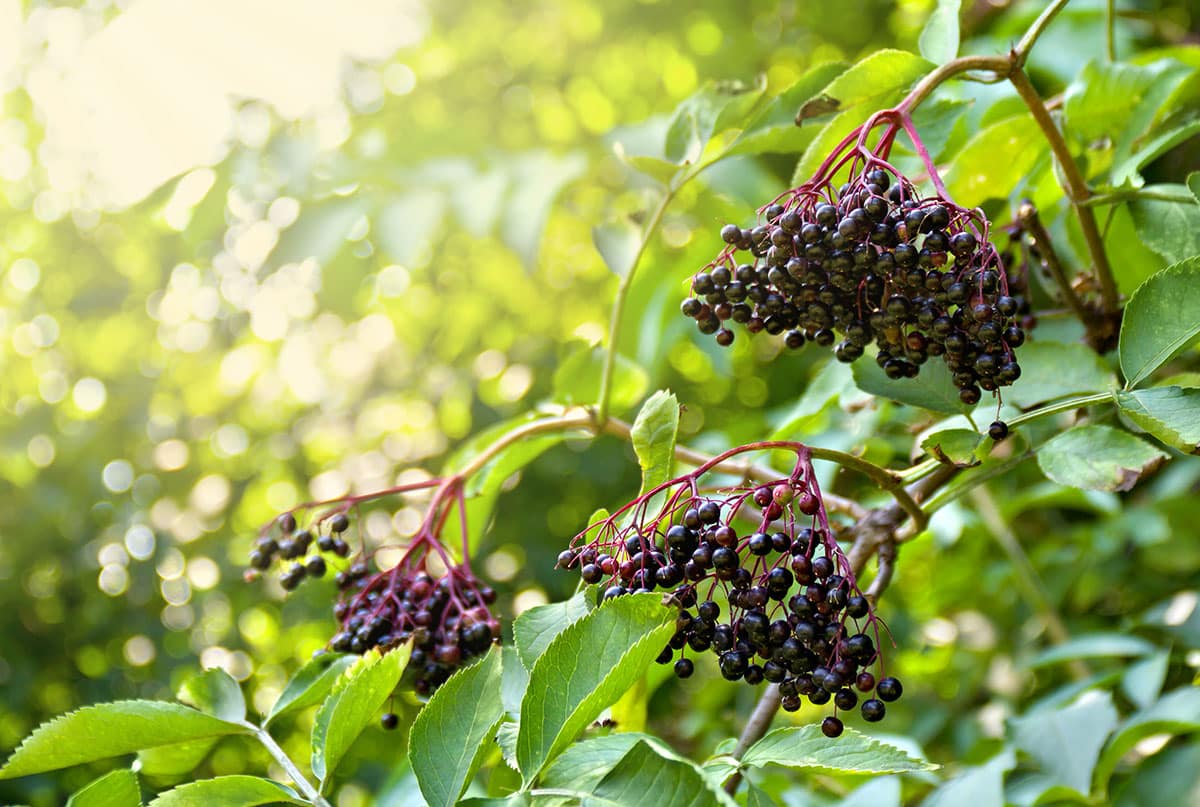
First off, I am talking about black or blue elderberries, which are Sambucus nigra, which has several subspecies. I don’t like red elderberries, which are S. racemosa, but some people do. This article doesn’t cover them.
Second, I am talking about ripe berries, not elderflowers, which come earlier in spring. If that’s what you’re looking for, I have recipes for elderflower cordial, elderflower fritters and elderflower liqueur elsewhere on this site.
Finding Elderberries
Most of the 5o states, as well as parts of Mexico and Canada, as well as all of Europe have elderberries. This guide from the USDA should get you started on finding elderberries.
Elderberries like to live near water, but not be wet. I find them near rivers a lot, on well watered mountainsides, even in large hedgerows in places like France and England. They are a large bush or sometimes a small tree — there’s a 20-foot tree living near my home in Folsom, California.
The berries are on large bunches, and will often droop down when they are getting ripe. I’ve never seen elderberry season start before May, even in Florida, although in recent years things have been ripening earlier and earlier.
In most places, elderberries don’t come ripe until September, but in the South and Southern California they can ripen as early as May, and here in NorCal we start getting ripe elderberries in late June. Elderberry season starts in earnest in the Sierra Nevada in September, as you get higher in altitude.
So depending on where you go, you can get ripe elderberries from May until November.
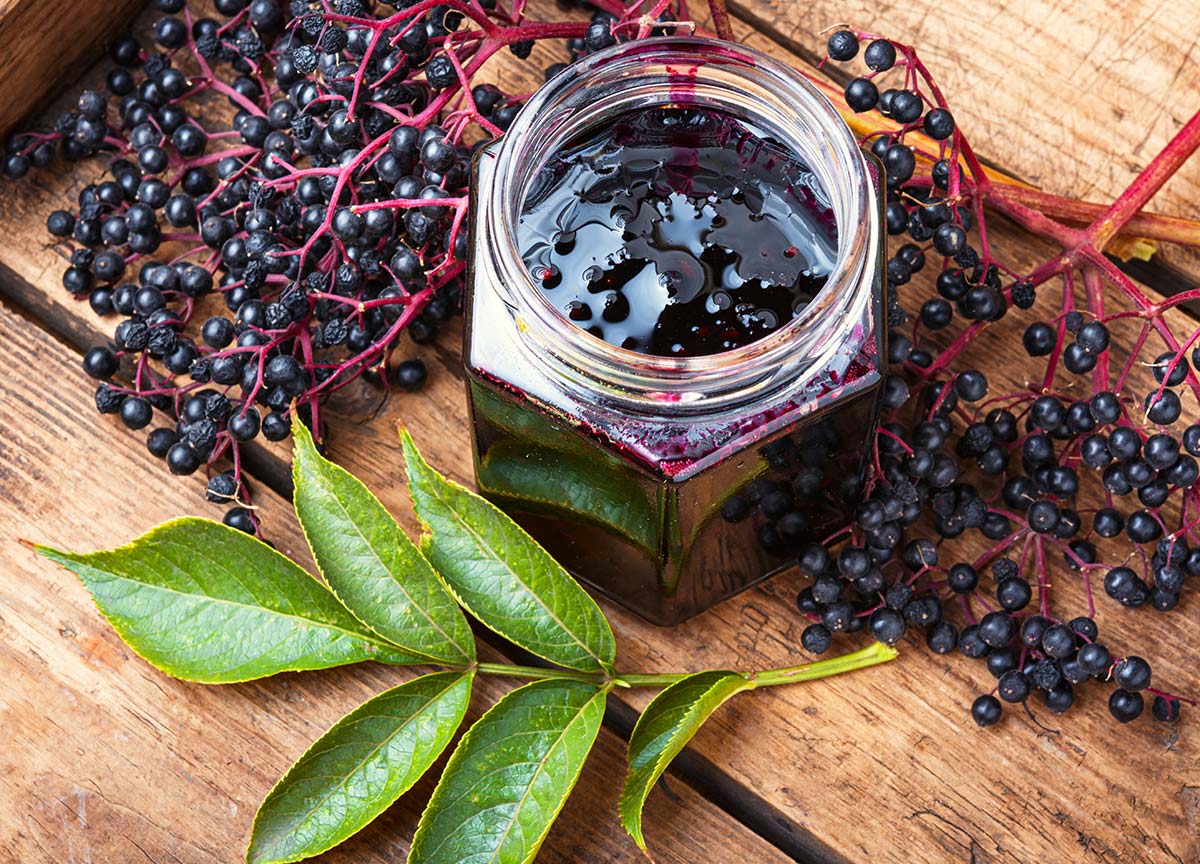
This photo shows elderberry leaves really nicely, as well as the ripe berries. Note the red stems. This is key. Harvesting elderberries before they are fully ripe will give you problems when it comes time to remove them from the stems. Ask me how I know. These are still unripe:
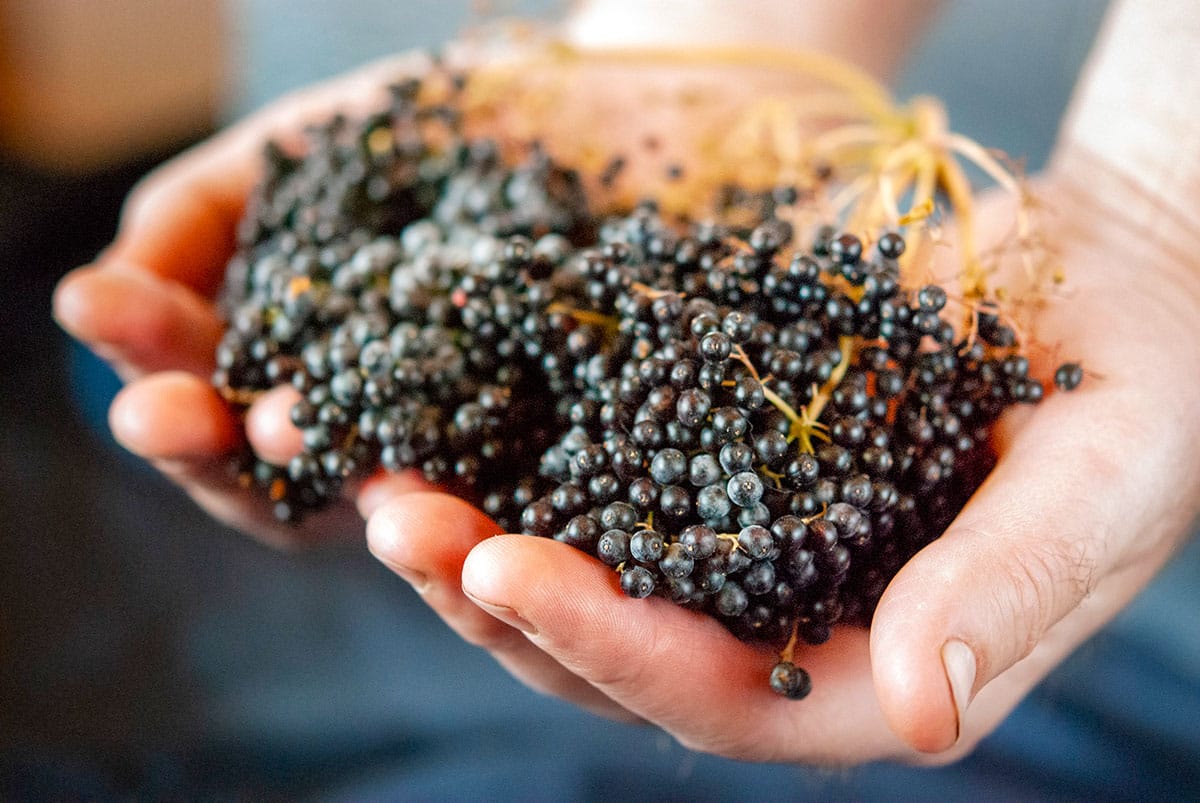
See the green stems? Yeah, they were a bear to get off the stem.
Harvesting Elderberries
The secret to elderberries, it seems, is that they are a rolling bush: Parts of some bushes are still in flower while the berries below have already ripened. Even when I picked my stash of elderflowers in May there were green berries on some.
Incidentally, you should know that the stems and unripe berries are toxic — not horribly so, but you want to minimize them in any elderberry recipe — and some people get an upset stomach eating raw elderberries. I do not, but some I know to.
Beware, slackers! Ripe elderberries are sweet — sweet enough that the deer like them very much. We saw a lot of nibbled-off spots on the bushes while harvesting elderberries in summer. By September I suspect the only remaining elderberries will be too high for the deer to get; and then you need to worry about birds.
I use a knife or scissors to cut off the bunches, collecting them in a paper grocery bag. Gather several bags, so you have plenty to work with.
Once you get your elderberries you need to take the berries off the stem, which can take some time.
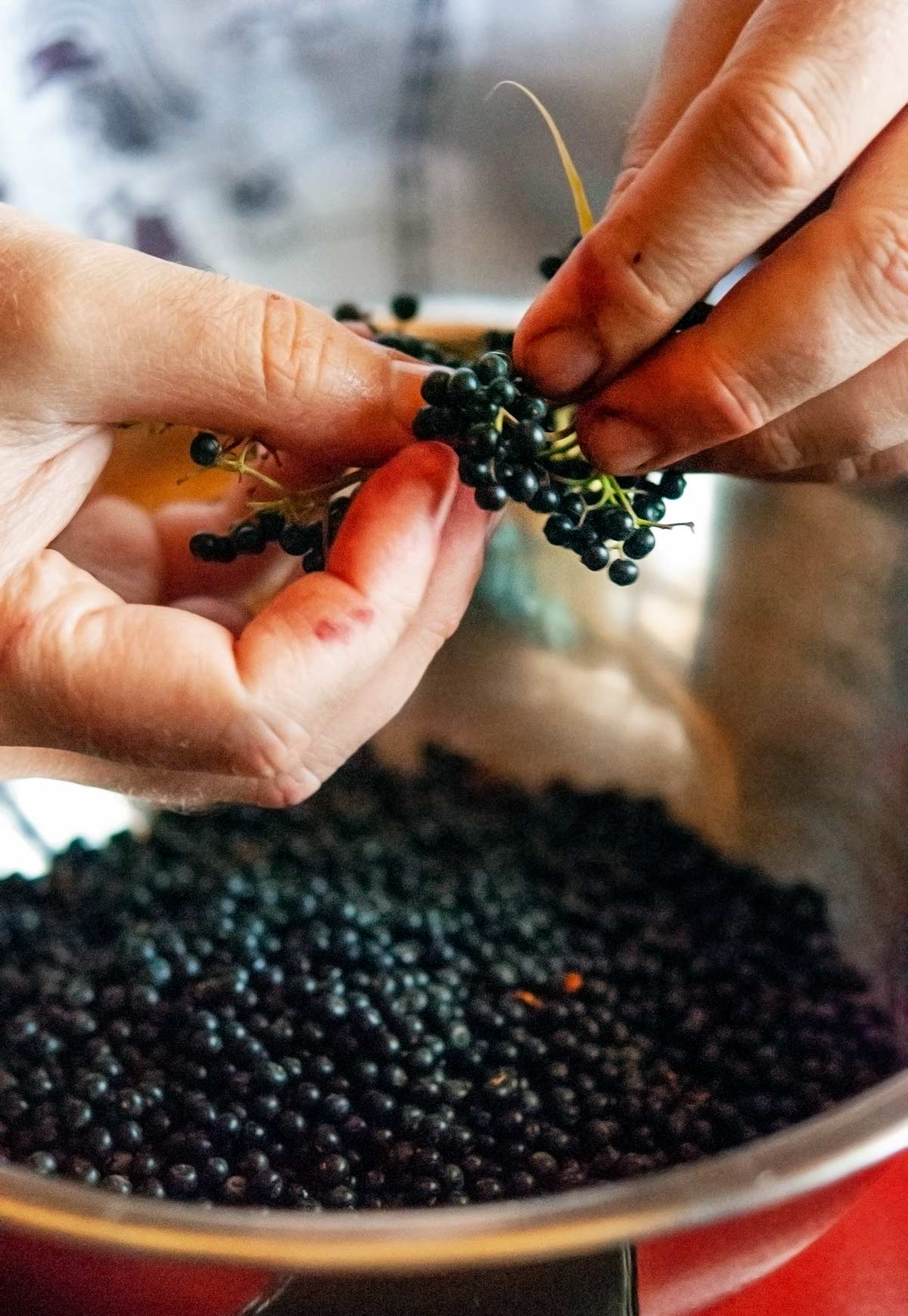
This is the least fun part of dealing with elderberries, but it needs to be done: The stems and leaves of the plant are toxic, and definitely bitter. You need to be patient and have a light hand, however, as the berries are fragile. Work with small portions of each cluster at a time, and gently rake your half-open hand over the berries, letting them fall into a bowl set beneath you.
Again, let me stress the word “gentle.” Unripe berries hold onto the stem, ripe ones fall off easily. And you don’t want to eat unripe berries.
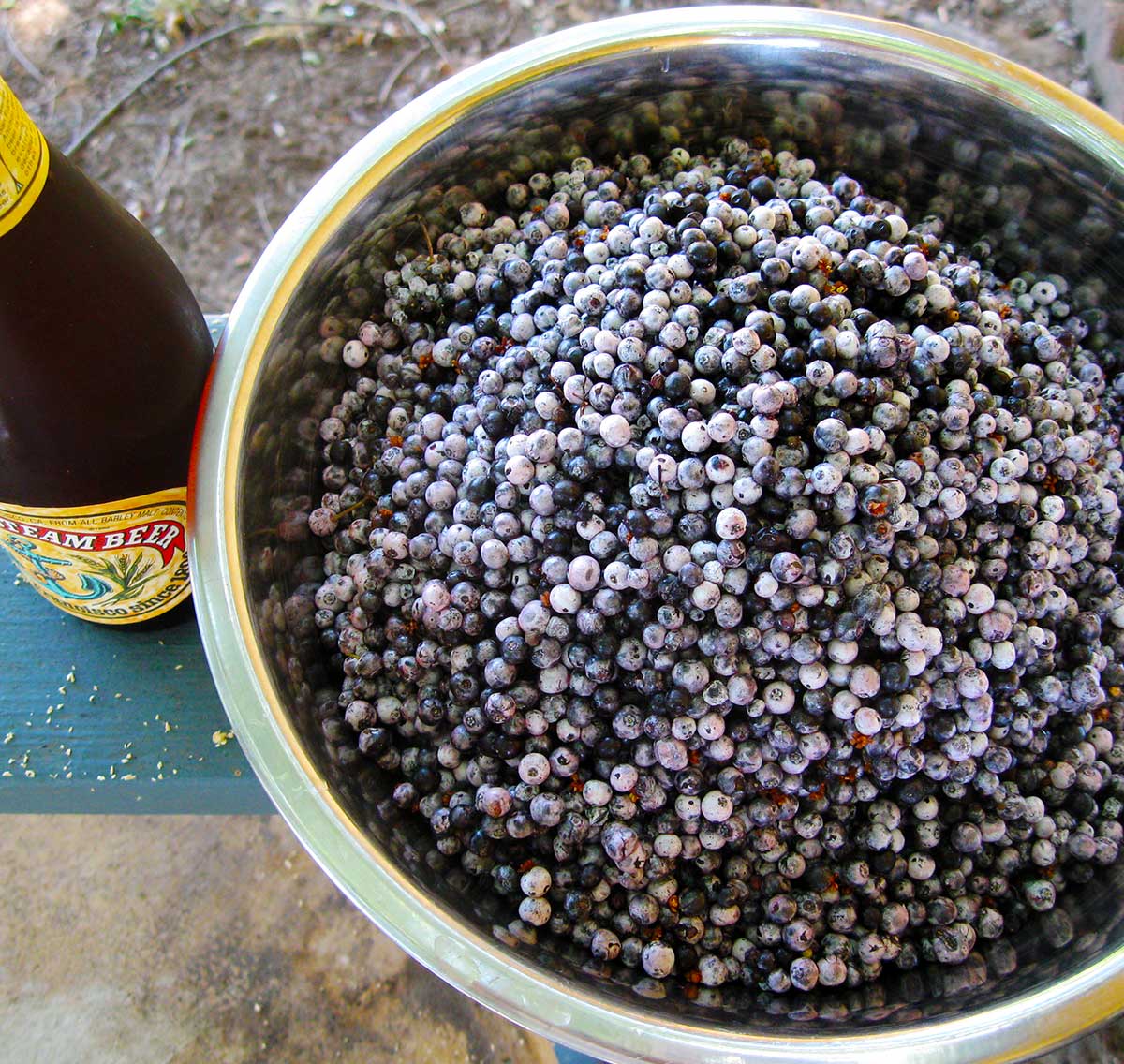
Cooking with Elderberries
What to do with all these berries? Admire them, to start. Poured into a large, flat Tupperware, they look like $10,000 worth of caviar: Shiny, tiny black orbs. So pretty! Dip your face close, and you will get the unmistakable aroma of winegrapes.
It was at this moment I realized just how good these could be in the hands of a competent winemaker — only you’ll never find one working with elderberries in California, as this place heaps so much scorn on “fruit” wines that I can barely mention them in public. Tyranny of the Grape, I call it.
I make elderberry wine every couple years. To do it right you need a lot of berries. I reckon at least 3 pounds per gallon, and 5 pounds per gallon is better.
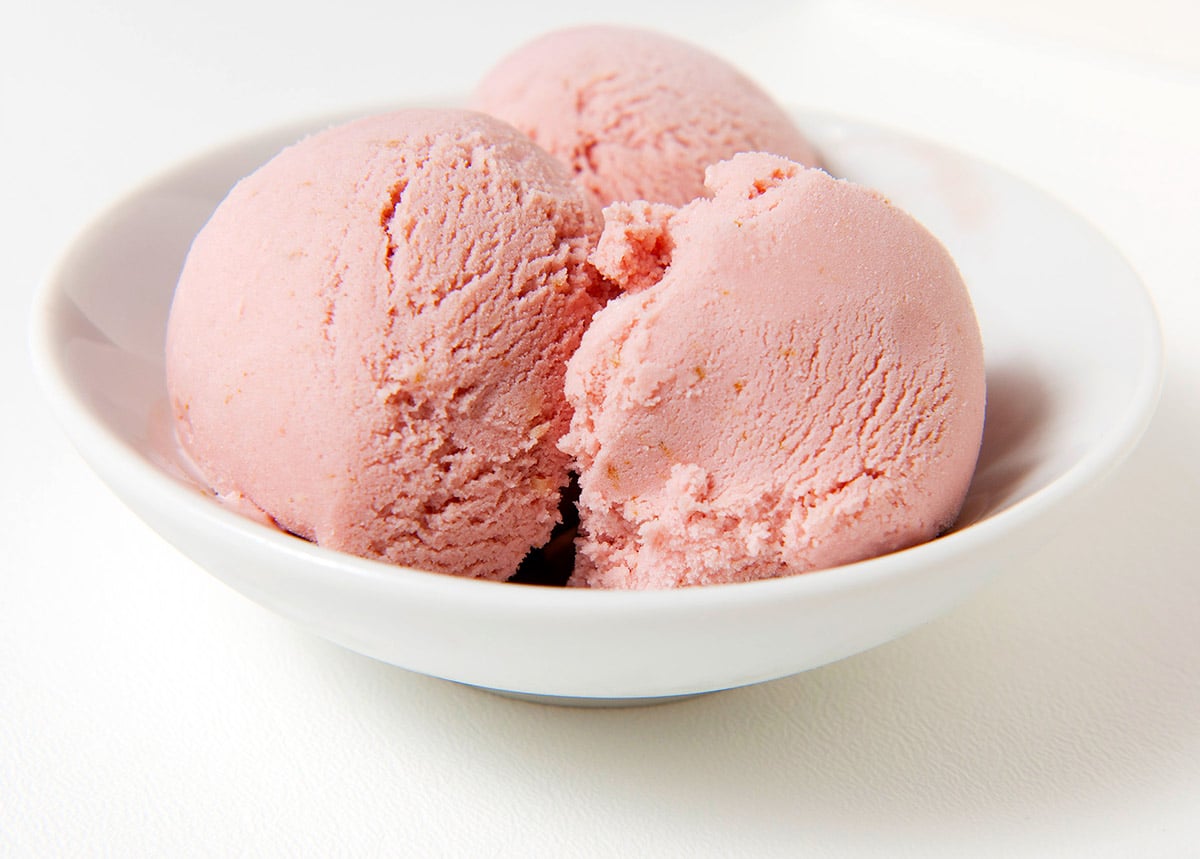
I also make elderberry liqueur with whole berries in vodka with lemon zest. It’s damn good with just a little bit of added sugar.
Elderberry syrup is a great base for the classic Cumberland sauce I make to go with wild game such as duck and venison. You can also use the syrup to make an Elderberry Ice Cream.
The British also make a curious condiment with elderberries called Pontack. It’s a little like a vinegary mashup between elderberry syrup and Worcestershire. It’s really good with venison and duck.
Preserving Elderberries
May favorite ways to preserve the harvest from elderberry season are the aforementioned syrup, wine, liqueur, and pontack. But after harvesting elderberries you can dehydrate them for another day. Set your dehydrator to 135°F for, well, a while. It takes up to 14 hours to get them leathery.
You can also pickle elderberries in a similar way to pickled blueberries.






Up here in Alaska, we have red elderberries (Sambucus racemosa var. racemosa) everywhere. Would they be good in these recipes? Or are the black ones more flavorful then red?
Suzanne: No, red elderberries are not very tasty. Red huckleberries, on the other hand, are amazing.
Im in Florida and I love making elderberry wine and medicines from freah berries. It’s a big part of my flue and cold remedy along with Valerian and turmeric.
Have you ever tried to pickle the unripe green berries like capers? The flower buds are so tiny and I’d like to try using the green elderberries in something not sweet. Any ideas?
Sherri: I have. You ferment them with about 2.5% salt by weight, or brine them. They’d pretty good, but not as good as real capers.
I have also used elderberries that stayed green even when ripe. They are very sweet. Seems that some of the trees do that yet are identical otherwise to the trees with darker berries. Berry interesting!
Suzanne: Where are you, in Southern California? They get them there.
Hi, I am from Winnipeg Canada, I have a question. I brought some bushes from Ontario near Toronto. My sister, living near Toronto and I have the same problem. Our green elderberries always disappear off the bushes, and don’t stay until they ripen. I can’t see any bugs. We both have plants from our mother’s bush on the farm which always produced lots of ripe berries.
Also, do you need two trees to pollinate the flowers?
Carolyn: It’s birds. If you have green berries, they are pollinated. Maybe net the bushes to keep the birds away?
Thank you for the info about the green/white elderberry variant, Hank. I’m in South Orange County, CA and have found many elderberry with this description as well as the Sambucis Cerulean. I made syrup from the two varieties and look forward to using it.
Thanks for trying, Hank. If there is ayone else who has ever encountered this, please let me know. I’ve been observing my elderberries in North Hollywood, CA closely for a couple of weeks, since last posting. The berries do develop a whitish-blue ‘bloom’ on the outside, so they look almost identical to pictures I’ve seen of other blue elderberries. The difference is, the berries underneath the pale-blue ‘bloom’ remain green – all the way thru maturity and until the time they begin to shrivel and die. Even when fully ripe, they never turn a dark, purply-blue, underneath the whitish-blue coating – which is the colour I’ve read they should be, when ripe. Birds don’t seem to eat these berries, but they might & I might just be missing it. The birds may eat berries at the top that I just don’t notice…. and birds may prefer the shrivelled raisins – but I haven’t seen birds eating those, either. Should I take this as a sign that these berries could be so toxic that they should not be consumed, even if cooked? Have u ever heard of very old, wild Elderberry species in California where the berries do have the whitish-blue coating but, underneath, remain green even when fully ripe? I wanted to try cooking some up in a compote, but don’t know if I should. Perhaps I’ll try, anyway and let taste be my guide. If too bitter after cooking with the called-for amount of sugar, I’ll have to give up. But hope someone who’s encountered these same berries could shed some light on the subject. Thank you! – Sarah
Sarah: Actually, I have since heard from my friend Pascal Baudar, an LA County forager, that there is a weird variant of elderberry down there that is white/green. He uses them all the time, so I’d go for it.
I have a 1915 farmhouse on a large, old, un-spoiled plot of land in The San Fernando Valley of Los Angeles, & my neighbors, (who have a similar lot), and I have two large Elderberry Trees that are obviously old, native and wild – which we can’t identify by species. The pale white flowers and toothed, pinnate leaves of five to eleven in number are exactly the same as in countless photos I’ve seen of blue and black Elderberry – – – the difference is, the average-sized berries are medium green and slightly translucent, and even when ripe, they never change colour. I’ve seen this same type of Elderberry growing in other parts of the San Fernando Valley, La Crescenta and in the low-foothills of Griffith Park, between Burbank and Hollywood. Even though perfect for nests, birds never nest in my tree & I’ve never seen a bird eating the green, ripe Elderberry berry nor the dark Elderberry raisin that is left when it dies and shrivels. Can u tell me what species this is? Can the dried flowers be used to make tea, as with blue or black Elder flowers, (which look identical – only the colour of the ripe berry is different), and can these green, ripe Elderberries be used to make medicinal tinctures? Since birds don’t eat these green berries, even when fully ripe, I’m wondering if this is a highly-toxic form of Elder and if u think it’s possible that it could remain toxic, even after being stem-and-seed-strained and cooked. Please weigh in with your expert advice!
Sarah. Sorry, no idea.
We freeze our berries (about 40lbs this year, so we can’t deal with them all at once) in clear garbage bags. When they are good and frozen, I’ve learned that by banging (gently,repeatedly) the bag up and down on a flat surface, like a freezer lid, the stems and other debris will “float” up to the top and can simply be lifted away. I get them cleaner this way than when I was doing them fresh, and it doesn’t make a mess. It seemed like a miracle when I discovered this after having spent hours and hours trying to remove stems from fresh berries or trying to go through frozen berries by hand to remove all the bits.
I foolishly followed advice on another website to freeze the heads of elderberries before de-stalking. I ended up with loads more bits of stalk than when I have stripped them off using a fork. Far more than I can pick out now by hand. If I boil and strain the berries for the elderberry rob I plan to make (not sure if you have that in the US – it’s basically a cordial) the stalky bits will be removed but will the juice be toxic. Maybe I will have to go and pick more elderberries and start over. I hope not.
Thanks for any advice.
Glynis: You should be OK. The toxicity of the stems isn’t dramatic. Just do your best to remove them and carry on.
I’m in Ohio and the green elderberries are falling off the stalks. Could this be because we have had so much rain?
Research has shown that they were a staple of west coast native diet. I’ve made jelly several times and never experienced any problems.
Daryl: Yep, you are correct. And no one has trouble with the cooked fruit, just the raw.
wondering how to go with removal of green bits in the red elder flowers….. it might take me a month to separate out the flowers if I worry about the little green pre-berry nub in the center………..is that part really worth worrying about?
Diana: Don’t eat red elderberries. They are borderline toxic. No reputable forager recommends them. Sorry.
We make up a fresh batch of elderberry juice each year and freeze, take out a pint when needed to keep a supply of elderberry ‘medicine’ handy for flu/colds season. Just add honey and lemon juice. Some add a little ginger as well. I take my dose in a tea. 🙂
The article was frustrating since here I sit in early October in zone 5, Ohio and the elderberry clusters are in so many stages. Some are blooming, most are small and green, some are red and a few have ripened. Even in the same clusters, if I wait for the berries to get large and black, they fall off or dry before the cluster can be picked. As for the wine, which we have made for years- instead of using fewer berries we have found that the density is such, we have had to cut back. We usually use about 22 pounds of any other type of fruit per five gallon, but for elderberry we use 18.
I just realized that my town is SURROUNDED by blue elderberry bushes, most of which are perfectly ready for picking (3500ft elevation, southern California.)I went out today and gathered somewhere between 5 and 10 pounds from the side of the road, but it took literally hours to process them. I guess I failed to read the hint about freezing -before- trying to remove them from the stems. Oh well! It was novel the first time around, at least. Many of the trees still have green berries, so I’ll try the freeze-first method after the next ripening. Thanks for your tips on this website and to all of you who helpfully commented!
So glad to find your site; it and the accompanying comments are a wealth of information! I already freeze my elderberries before I de-stem them, but am eager to try the fork idea (no Afro pick handy just now). Glad to hear that the tiny stems aren’t crazy toxic, as it was driving me crazy trying to get them all out. Here’s my question: we’ve had wild elderberries and “cultivated” ones and none of them have much flavor at all until honey or other sweetener is added. Are there really some varieties that taste sweet when raw? Maybe this is a personal taste bud variance issue … ?
And here’s a recipe for elderberry custard pie (from The Mennonite Community Cookbook; I’ve also made plain old elderberry pie but we were really turned off by the grit of the seeds):
1 cup elderberry juice
1/4 cup flour
1 cup sugar
1/4 tsp. salt
1/4 cup milk
1 egg, separated
3/4 cup milk
pastry for 1 9″ pie crust
Bring elderberry juice to boiling point. Combine flour, sugar, salt. Add 1/4 c. milk. Add paste to juice and cook till thickened. Remove from heat and add egg yolk and 3/4 cup milk. Fold in stiffly beaten egg white. Pour mixture into unbaked pie shell and bake at 350 degrees F for 30 minutes.
Entering the conversation a little late (ya think?) but elderberries are starting to ripen here. We picked some really black bunches today, and a few bunches (heads?) that had black and dark red berries on them. Okay to make jelly with these? Also, I’m finding it very difficult to get every little stem out of the berries even after “freezing and forking.” There’s so little info on elderberries, so does anyone know if its okay to include the tiny stems while making juice which will be strained before making jelly? Thanks!
Yep, you’re fine. The stems aren’t THAT toxic, but you do want to get as many out as you can. A few stray ones won’t hurt you.
Hi there,
Very interesting reading your comments. I live in a southern part of Australia and have grown Sambucus nigra. (European Elderberry) for years, enjoying the wine and syrup. I grow them in large quantities for they are enjoying more popularity than ever. 🙂 Would like to promote this plant more for its medicinal qualities.
I just found you by looking for elderberry pie recipe(s) and I have found a very interesting sight but no recipe for pie! I am an ex-pat Canadian living now for some time in Denmark where elderberries grow like mad all over the countryside and fortunately there are several trees on our property in a country village just south of Copenhagen. Elderberries are very popular here and especially the flowers which are made into a drink widely used and available readily in supermarkets. I recall very fondly acquiring the odd homemade berry pie on the Farmers’ Market in London, Ont. and I would dearly love to try my hand at making it myself. We have masses of berries this year which, Ontario Mennonite-style, I do not want to waste otherwise “the trees won’t bloom or bear next year”. Can you help me with at least one recipe? Please! and thanks very much.